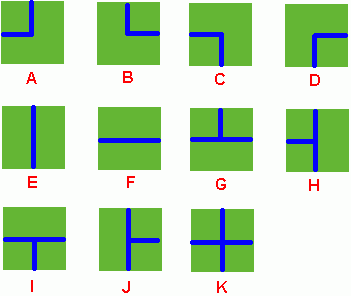hdu1198 Farm Irrigation ----并查集
来源:互联网 发布:相关系数软件 编辑:程序博客网 时间:2024/06/01 08:04
原题链接: http://acm.hdu.edu.cn/showproblem.php?pid=1198
一:原题内容
Problem Description
Benny has a spacious farm land to irrigate. The farm land is a rectangle, and is divided into a lot of samll squares. Water pipes are placed in these squares. Different square has a different type of pipe. There are 11 types of pipes, which is marked from A to K, as Figure 1 shows.

Figure 1
Benny has a map of his farm, which is an array of marks denoting the distribution of water pipes over the whole farm. For example, if he has a map
ADC
FJK
IHE
then the water pipes are distributed like

Figure 2
Several wellsprings are found in the center of some squares, so water can flow along the pipes from one square to another. If water flow crosses one square, the whole farm land in this square is irrigated and will have a good harvest in autumn.
Now Benny wants to know at least how many wellsprings should be found to have the whole farm land irrigated. Can you help him?
Note: In the above example, at least 3 wellsprings are needed, as those red points in Figure 2 show.

Benny has a map of his farm, which is an array of marks denoting the distribution of water pipes over the whole farm. For example, if he has a map
ADC
FJK
IHE
then the water pipes are distributed like

Several wellsprings are found in the center of some squares, so water can flow along the pipes from one square to another. If water flow crosses one square, the whole farm land in this square is irrigated and will have a good harvest in autumn.
Now Benny wants to know at least how many wellsprings should be found to have the whole farm land irrigated. Can you help him?
Note: In the above example, at least 3 wellsprings are needed, as those red points in Figure 2 show.
Input
There are several test cases! In each test case, the first line contains 2 integers M and N, then M lines follow. In each of these lines, there are N characters, in the range of 'A' to 'K', denoting the type of water pipe over the corresponding square. A negative M or N denotes the end of input, else you can assume 1 <= M, N <= 50.
Output
For each test case, output in one line the least number of wellsprings needed.
Sample Input
2 2DKHF3 3ADCFJKIHE-1 -1
Sample Output
23
有如上图11种土地块,块中的绿色线条为土地块中修好的水渠,现在一片土地由上述的各种土地块组成,需要浇水,问需要打多少口井。能相连的地只需要打一口井。
容易想到并查集。只需要对每个地块与右方和下方的地块进行合并即可。合并之前先判断是否能连通,若能连通则合并,不能连通,则不能合并。能连通的时候就是正常的并查集了。
三:AC代码
#include<iostream> #include<algorithm> using namespace std;int type[11][4] = { { 1,1,0,0 },{ 0,1,1,0 },{ 1,0,0,1 },{ 0,0,1,1 },{ 0,1,0,1 },{ 1,0,1,0 },{ 1,1,1,0 },{ 1,1,0,1 },{ 1,0,1,1 },{ 0,1,1,1 },{ 1,1,1,1 }};int pre[55 * 55];char farm[55][55];int cnt;int m, n;int maxx;void init(int n){for (int i = 1; i <= 55*55; i++)pre[i] = i;cnt = n;}int find(int x){if (x == pre[x]) return x;pre[x] = find(pre[x]);return pre[x];}void join(int ax, int ay, int bx, int by, bool dir){if (bx > m || by > n) return;bool flag = false;//标识两块地是否可连int ta, tb;ta = farm[ax][ay] - 'A';tb = farm[bx][by] - 'A';if (dir)//竖直方向判断可连性{if (type[ta][3] && type[tb][1])flag = true;}else//水平方向判断可连性{if (type[ta][2] && type[tb][0])flag = true;}if (flag){int root_a = find(ax*maxx + ay);int root_b = find(bx*maxx + by);if (root_a != root_b){pre[root_a] = root_b;cnt--;}}}int main(){while (~scanf("%d%d", &m, &n) && (m > 0 && n > 0)){init(m*n);maxx = max(m, n) + 1;for (int i = 1; i <= m; i++)scanf("%s", farm[i] + 1);for (int i = 1; i <= m; i++){for (int j = 1; j <= n; j++){join(i, j, i + 1, j, true);join(i, j, i, j + 1, false);}}printf("%d\n", cnt);}return 0;} 1 0
- HDU1198(Farm Irrigation)-并查集
- HDU1198-Farm Irrigation(并查集应用)
- Hdu1198 - Farm Irrigation - 并查集
- hdu1198 Farm Irrigation ----并查集
- hdu1198 Farm Irrigation(DFS,并查集)
- 【hdu1198】Farm Irrigation——并查集
- hdu1198 Farm Irrigation —— dfs or 并查集
- hdu1198 Farm Irrigation 并查集或者dfs
- 【并查集】Farm Irrigation
- Farm Irrigation(并查集)
- hdu 1198 Farm Irrigation(并查集)
- HDUOJ 1198 Farm Irrigation(并查集)
- hdu 1198 Farm Irrigation( 并查集)
- HDU 1198 Farm Irrigation(并查集)
- HDOJ 1198 Farm Irrigation 并查集
- HDU 1198 Farm Irrigation 【并查集】
- HDU 1198Farm Irrigation(并查集)
- HDU 1198 Farm Irrigation(并查集)
- Linux 学习
- Smoke Test
- numpy学习笔记
- sched_yield()函数 高级进程管理
- Struts2 的输入验证
- hdu1198 Farm Irrigation ----并查集
- Linux Shell 文件描述符 及 stdin stdout stderr 重定向
- TortoiseSVN文件夹及文件图标不显示解决方法
- Android ImageView图片浏览器(ImageView加载sd卡图片资源)的内存溢出问题分析
- Genymotion模拟器和常见问题
- 第12章 段式内存管理
- 装苹果
- JDBC滚动结果集、SQL注入、处理大数据、批处理、DAO模式介绍
- 剑指offer之面试题29数组中出现次数超过一半的数字


